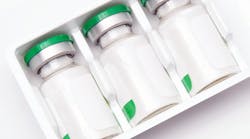How New Packaging Technologies are Helping in the Struggle Against Counterfeit Drugs
The global pharmaceutical supply chain is at growing risk from counterfeit drugs, costing companies billions and putting the health of patients in danger. Secure packaging is an important factor in combating fake products. This has resulted in the enforcement of stringent legislation to make sure that pharmaceutical packaging cannot be easily imitated. Through the use of new anti-counterfeiting technology pharmaceutical packaging manufacturers can easily produce secure packaging and fulfill government policies. This article discusses counterfeit drugs, current regulations and the latest packaging technologies.
The World Health Organization (WHO) currently estimates the global trade in counterfeit drugs to be worth £75 billion and will continue to grow at a staggering rate of 13% a year. WHO has also suggested that 1% of prescribed drugs in the developed world and 30% in parts of the developing world may be fake. The threat is even bigger on the internet, 50% of drugs bought on illegal online pharmacies are thought to be counterfeits. As the counterfeit trade grows and becomes more profitable the criminals are becoming increasingly sophisticated and capable in the way they package their products.
In addition to manufacturing fake drugs, counterfeiters are seeking to infiltrate the legitimate supply chain. This allows them to steal authentic shipments and redirect them to other markets, reselling them to their own profit. Another emerging threat to the security of the pharmaceutical supply chain is ‘third shift’ packaging production. This involves contractors or their staff carrying out extra, hidden production runs and selling the resulting genuine packaging to counterfeiters.
As a result, global regulatory bodies have introduced strict legislation to ensure maximum security of pharmaceutical packaging.
Regulatory Outlook
The WHO Expert Committee on Specifications for Pharmaceutical Preparations has stressed the importance of implementing a quality assurance program. In the relevant report [1], the committee focuses on the role of packaging in relation to the stability of pharmaceuticals and the potential for counterfeiting. It is specified that the design of the packaging must contribute to preventing tampering with, or the counterfeiting of, the enclosed medicinal products. Packaging must also carry the correct information and identification of the product.
The US Food and Drug Administration (FDA) enforces rule 21 CFR Part 211 [2], which specifies current good manufacturing practice for finished pharmaceuticals. Within this framework, the rule mandates that tamper-evident packaging should be used for over-the-counter (OTC) human drug products. According to the regulation, a tamper-evident package has one or more indicators or barriers to entry which, if breached or missing, can reasonably be expected to provide visible evidence that tampering has occurred. It should not be able to duplicate the packaging using commonly available materials or processes.
In 2003, in response to the increasing number of counterfeiting incidents, the US FDA formed a Counterfeit Drug Task Force [3]. The force aims to create a comprehensive system of modern protective measures against counterfeit drugs. One of the measures is to ensure the security of packaging by using tamper-resistant tapes, holograms and color-shifting inks and dyes.
New secure packaging technologies have been developed to facilitate easy regulatory compliance.
Secure Packaging as an Anti-Counterfeiting Measure
Defeating the counterfeiters demands a multi-level approach, an element of which is secure packaging. However, in order to ensure optimal security of pharmaceutical packaging, both overt and covert technologies need to be used.
Latest technological advancements have seen the introduction of a multi-level range of solutions with which to ensure the security of pharmaceutical packaging in order to safeguard the supply chain and authenticate products within the global pharmaceutical market. The solutions incorporate sophisticated covert technology for use by customs agencies, authorized distributors and other parties with access to high tech readers or secure databases. They also feature advanced overt identification capabilities for users who have to rely on the evidence of their own eyes.
The new technologies offer the flexibility to be adjusted to the specific security issues and needs of each company. On that basis, they can incorporate a blend of features, from overt counterfeiting deterrents such as holograms and security seals, to invisible markers that can be placed anywhere on the package. These countermeasures can be fully integrated into wider solutions, such as electronic readers and secure database systems used by manufacturers, distributors or government agencies. The result is a suite of solutions that is effective at all stages of the supply chain, virtually anywhere in the world.
Overt Technologies
Overt features enable instant authentication of packaging through visual inspection by the user without requiring expert knowledge. Optically variable features such as holographic devices within the design and color shift inks are the most common and effective overt security features, enabling packaging to be validated both quickly and easily.
Holography
Easily identifiable holograms, showing the pharmaceutical manufacturer’s logo for example, are primarily used as first level identification devices and are designed to enable successful authentication at point of inspection. Additional features, such as nanotext and hidden images, can be used as second and third level techniques for trained and equipped specialists.
High security holograms cannot be reproduced by using conventional printing methods available on the market. In addition, tiny holographic markers can be printed in a predetermined position on the packaging. These markers are clearly visible when viewed with a magnifier, but invisible to the naked eye.
Whilst holograms offer a high level of overt security on their own, they can also be used in combination with other security devices to provide another hurdle for would-be counterfeiters to overcome, including color shift inks.
Color-Shift Inks
Color-shift inks appear as two or more distinct colors when viewed from differing viewing angles. Such features are easily verified by tilting the item carrying the color-shift in order that the different colors can be seen. Different color combinations are available and both strong opaque and subtle transparent effects can be created to complement the existing design of the packaging.
Currently, only a limited number of security suppliers produce color-shift inks since the process to create the color-shift pigment is highly specialized requiring particular technical knowledge and bespoke equipment. Supply of color-shift inks is tightly controlled to ensure that the products are used only in genuine circumstances and under strict codes of conduct including end use agreements.
Covert Technologies
The level of packaging security can be further increased with the introduction of covert and forensic features. Covert techniques such as infra red (IR) and ultra violet (UV) pigments, microtext and microscopic tagging are invisible and difficult to detect and replicate without specialist detection equipment. As a result, they provide a higher level of protection. Forensic solutions include molecular markers and biological tracers. These features can only be identified using laboratory equipment, offering complete confidence in packaging authentication.
UV Inks and Print
The images printed with a UV ink are only visible under a UV light. UV inks are available in different frequencies. Depending on the formulation of the ink, the investigators will need to use either a long wave or short wave UV light in order for the printed images or text to become visible. Images and text can be printed in a variety of UV colors ranging from blue to yellow to red. Even UV ‘picture’ images can be printed in full color or black and white, with grey scale or 'flesh tones' that are again only visible under a UV light source.
The level of security with UV inks and print is defined by the limited access to the inks and their component pigments with a genuinely secure range of inks only available under restricted use measures. By combining the colors to create photographic images, the level of security is further increased due to the highly specialized origination and printing techniques required.
Sophisticated printing capabilities also allow for the creation of fine line designs as well as color and UV microtext prints, similar to those used in bank notes.
Color and UV Microtext Print
Microtext print creates text characters which cannot be seen with the naked eye and can therefore be hidden within larger overt images such as text and pictures without the knowledge of the consumer or potential counterfeiter. These complex designs are hard to reproduce and can be further validated using a magnifying lens or microscope to examine the detailed features and sophisticated print. Such equipment is inexpensive, readily available and pocket-sized, making microtext print a very user- friendly technology.
Due to the need for specialist printing equipment, materials and technical knowledge, this technique is extremely difficult to copy. As the technology is covert, many counterfeiters simply do not attempt replication and create the overt image without the inclusion of microtext print.
Microtext can also be printed using a UV ink. In that case, the finished image is only visible under UV light and with a magnifying lens. The invisibility of this printing technology enables it to be used without affecting other design elements. Although the text size is slightly larger than with standard microtext print, the UV invisible ink considerably enhances security. Multi-color responses to UV light are available that further increase the level of security.
Added security is ensured by incorporating taggants on packaging to ensure reliable identification of the product and its source of manufacture.
Taggant Authentication
Taggant authentication technology provides a highly secure method for on-site or in-field applications. Pharmaceutical companies can integrate taggants to quickly protect and authenticate packaging in the market, through using most standard printing and coating techniques. Authentication is a key factor for the technology, which can reliably identify and distinguish genuine packaging from counterfeit ones.
The most highly secure taggant systems can only be verified with special handheld readers that are in turn only available from a secure source, thus ensuring that any potential counterfeiter is not aware of the presence of an authentication technology. Handheld readers are relatively low-cost, lightweight authentication tools that enable quick and easy authentication in different environments. Company personnel or authorized agents can simply and accurately determine whether packaging is authentic.
In general, overt and covert design features complement each other and are jointly used on packaging for maximum security.
Combining Overt and Covert Technologies
Security print techniques using highly defined print lines to create complex designs that are difficult to originate and print are also highly effective in the fight against counterfeiting. Sophisticated overt and covert security design features, created using the latest software, can be built into each design, protecting pharmaceutical packaging from counterfeit.
A wide variety of fine design techniques can be combined to build bespoke security solutions into packaging protection and authentication requirements. These include engraved images, relief images, warp grids, variable line width, guilloche designs, crystal patterns and special rasters.
Security Tear Tape
Finally, in addition to the different overt and covert security techniques and technologies that can be used to protect products, the carriers that these security devices feature on also offer an opportunity to “out fox” the counterfeiter. Using materials that are available from a relatively small numbers of sources makes it even more difficult to create a convincing “pass-off”.
One such example of this is in the use of security tear tape in combination with shrink sleeves as an anti-tamper solution around bottle caps. The tear tape is an ideal medium to integrate a brand protection solution into product packaging. It can carry a variety of sophisticated brand protection features available from overt and covert authentication and tamper- evidence technologies.
The tear tape technology provides solutions for authentication, tamper evidence and product coding. It is virtually impossible to remove the tear tape without destroying it, thereby preventing opening packs, refilling and resealing them without detection. In addition, the removal of the tear tape from the original packaging can be designed to damage the pack surface, leaving behind a void/ tampered message on the pack. This means that the original tear tape cannot be reused by the counterfeiters. As a consequence, counterfeit products are prevented from infiltrating genuine batches.
Conclusion
The pharmaceutical packaging counterfeiting threat is continually developing and new secure techniques have been developed to combat it. Overt, covert and forensic technologies are applied to ensure that packaging cannot be reused or misappropriated. Anti-theft, tamper- evidence and authentication solutions enable inferior and potentially harmful counterfeit products to be reliably intercepted and stolen genuine products recovered. By implementing the new security techniques, robust and reliable protection from tampering, copying and brand infringement is enabled and counterfeiting becomes a difficult and costly process.
References
1. WHO EXPERT COMMITTEE ON SPECIFICATIONS FOR PHARMACEUTICAL PREPARATIONS, Thirty-sixth Report
2. US Food and Drug Administration, CFR - Code of Federal Regulations Title 21 FOOD AND DRUGS, CHAPTER I--FOOD AND DRUG ADMINISTRATION DEPARTMENT OF HEALTH AND HUMAN SERVICES, SUBCHAPTER C--DRUGS: GENERAL, PART 211 -- CURRENT GOOD MANUFACTURING PRACTICE FOR FINISHED PHARMACEUTICALS, Subpart G--Packaging and Labeling Control, Sec. 211.132 Tamper-evident packaging requirements for over-the-counter (OTC) human drug products
3. US Food and Drug Administration, FDA Counterfeit Drug Task Force Reports
4. European Federation of Pharmaceutical Industries and Associations, WHITE PAPER ON THE ANTI-COUNTERFEITING OF MEDICINES, November 2005
5. Anti-counterfeiting Packaging Technologies in the U.S. Pharmaceutical and Food Industries, January 2007, BCC Research




